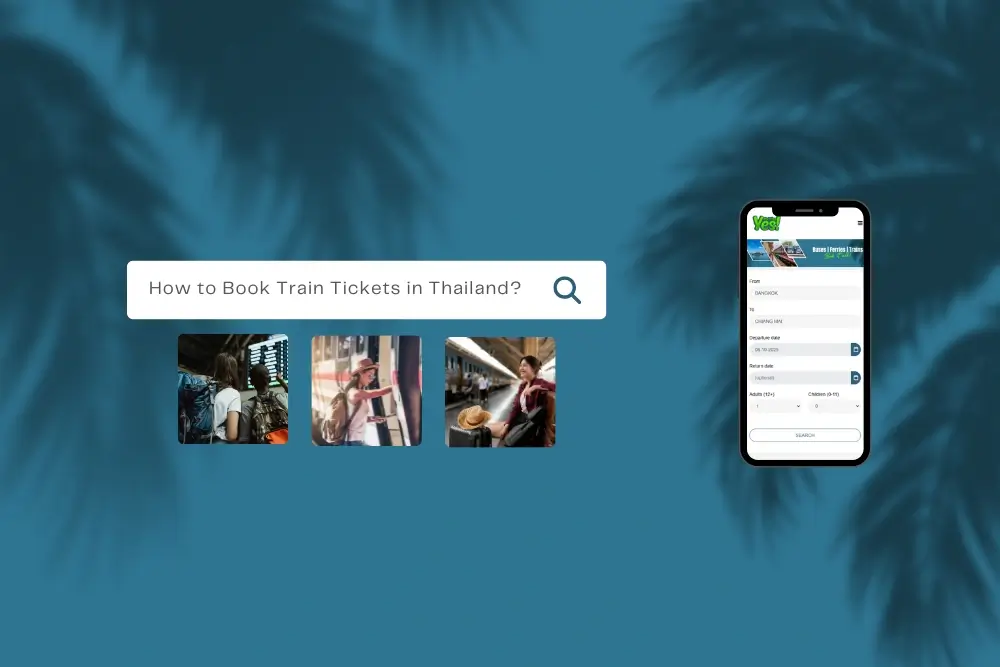Train travel in Thailand: Complete guide
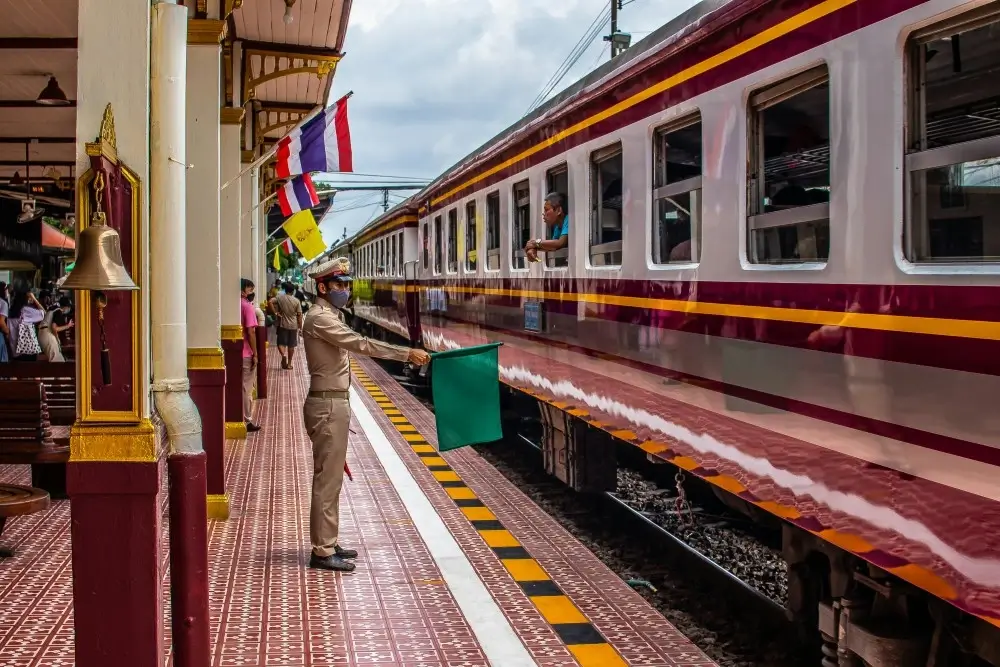
Train Travel in Thailand: The complete guide brings together everything you need to plan, ride, and confidently book train journeys across the country. From high-frequency commuter lines in Bangkok to overnight sleeper services between Bangkok and Chiang Mai, this guide explains train classes, essential routes, ticket types, and real booking tips. Follow our step-by-step advice to compare schedules, secure seats or sleepers, and complete your purchase on our site. You’ll receive your e-tickets conveniently via email.
Buy Train Tickets
Use the YesMyTrips widget to reserve your Thai train tickets today!
Compare prices, schedules and routes | Fast confirmation and e-tickets sent to your email.
Booking your Thai train tickets in advance with YesMyTrips guarantees you a seat, especially during peak travel periods or holidays, helping you avoid disappointment due to limited availability. It also allows for better trip planning and access to your preferred departure times and seats.
Why Travel by Train in Thailand?
Train travel in Thailand offers a practical yet immersive way to explore the country, combining efficiency with authentic Thai scenery, social interaction, and overnight comfort. It's the ideal choice for travelers seeking a balance between speed, affordability, and unique experiences: faster and more comfortable than buses, cheaper and more scenic than flights, with opportunities to see rural life and meet locals along the way.
• Scenic Routes That Enhance Your Journey:
Travel along iconic corridors like Bangkok to Chiang Mai or the Southern Line to witness lush rice paddies, jungle-covered hills, coastal vistas, and bustling small stations, transforming travel time into sightseeing opportunities.
• Cost-effective and transparent pricing:
Train fares generally lower than flights and free from dynamic pricing, train tickets and advance sleeper reservations offer predictable and budget-friendly options, making planning simple and straightforward.
• Comfort for long distances:
Overnight sleeper trains provide comfortable bunks, bedding, and privacy, enabling you to arrive rested and save on hotel costs. During the day, spacious seats, the ability to move around, and dining cars make longer journeys pleasant.
• Local contact and cultural texture:
Trains are lively social spaces where locals and tourists mingle, vendors sell regional snacks at stations, and stops reveal daily Thai life, adding authentic cultural flavor to your trip.
• Reliable and safe public service:
Operated by the State Railway of Thailand, train services run on regular schedules across the network. While not the fastest option, they are dependable and low-risk for long-distance travel.
• Lower environmental impact:
Trains produce significantly fewer CO2 emissions per passenger compared to domestic flights, an eco-conscious choice for sustainable travel.
Ready to experience Thailand by train?
Overview of Thailand Railway System
Thailand’s railway network is a vital transportation backbone, stretching across the country and offering travelers one of the most affordable and scenic ways to explore its diverse landscapes. The system is managed by the State Railway of Thailand (SRT), a state-owned enterprise under the Ministry of Transport. Established in 1890 as the Royal State Railways of Siam, it was rebranded to its current name in 1951 and is headquartered in Bangkok.
The network primarily uses a narrow 1,000 mm meter gauge, with a total rail length exceeding 4,400 km as of 2025. Major corridors feature double and triple tracking, improving punctuality and capacity, serving over 90% of Thailand’s provinces. The train fleet includes various service levels:
• Special Express: fastest, most exclusive, limited stops.
• Express, Rapid, Ordinary: descending order of speed and comfort.
• Commuter trains: mostly operating around Bangkok and nearby regions.
• Local trains: servicing provincial routes.
Recent investments focus on modernization, including:
• Double tracking for better punctuality.
• High-speed rail projects (notably Bangkok–Nong Khai and Thailand-China HSR) with completion planned after 2027.
• Urban and airport rail links in Bangkok.
The network is mostly diesel-powered, with only a few electrified urban lines. Annually, SRT transports over 35 million passengers, serving both local commuters and long-distance travelers. Rail travel remains popular for its cost-effectiveness, scenic views, relaxed pace, and authentic glimpse into Thai rural and urban life. The system is also favored by budget-conscious travelers, students, and low-income citizens due to various discounts and social tariffs.
Traveling by train offers not only a practical mode of transportation but also a relaxing and culturally enriching experience, providing unique windows into the daily life of Thailand’s people.
Regional Connectivity and Major Lines
Thailand’s rail network centers around four main lines: Northern, Northeastern, Eastern, and Southern plus the independent Maeklong Railway. Each originates from Bangkok, connecting the capital with key cities, provincial towns, and international borders.
Northern Line
Stretching approximately 751 km, this line runs from Bangkok’s Krung Thep Aphiwat Central Terminal to Chiang Mai. Key stops include Ayutthaya, Lopburi, Nakhon Sawan, Phitsanulok, Lampang, and Lamphun. Known for its scenic beauty and cultural sites, there’s a branch diverging to Sawankhalok, and a new branch to the Lao border at Chiang Khong is under construction, enhancing regional links with Laos and China.
Northeastern Line
At Ban Phachi Junction, the line splits:
• One branch heads to Nong Khai (bordered with Laos), passing through Nakhon Ratchasima, Khon Kaen, and Udon Thani.
• The other covers Ubon Ratchathani, moving through Buriram and Surin.
International trains now extend to Khamsavath in Vientiane, Laos, reflecting growing regional integration.
Eastern Line
This route connects to Chonburi, Pattaya, Aranyaprathet (bordering Cambodia), Ban Phlu Ta Luang, and ports like Laem Chabang and Map Ta Phut. It mainly serves regional traffic but also links to Cambodia and the Eastern Economic Corridor.
Southern Line
Over 1,150 km, this vital line runs south from Bangkok to Nakhon Pathom, Hua Hin, Surat Thani, Hat Yai, and terminates either at Su-ngai Kolok (Malaysian border, east coast) or Padang Besar (Malaysian border, west coast). Branches connect to Trang, Kantang, and Nakhon Si Thammarat.
International Stations: Major border crossings include Padang Besar (Malaysia), Nong Khai (Laos), Aranyaprathet (Cambodia), and Su-ngai Kolok (Malaysia), facilitating significant cross-border travel.
Explore Thailand's regions by train!
Thai Railway Stations and What to Expect
Experience at Thai train stations varies from the grandeur of modern megahubs to the rustic simplicity of rural halts. Here’s what to anticipate at different types of stations:
Major Hubs
Krung Thep Aphiwat (Bang Sue) Station
Bangkok’s state-of-the-art rail hub since 2023, featuring 12 platforms, modern facilities, numerous ticket counters, food outlets, left-luggage services, clear signage, and air-conditioned waiting areas. It offers seamless connections to city bus lines and the MRT subway. All major northern, northeastern, and southern services depart from here.
Features:
• Wide road beside the station with curved roof and glass facade.
• Taxis and buses readily available.
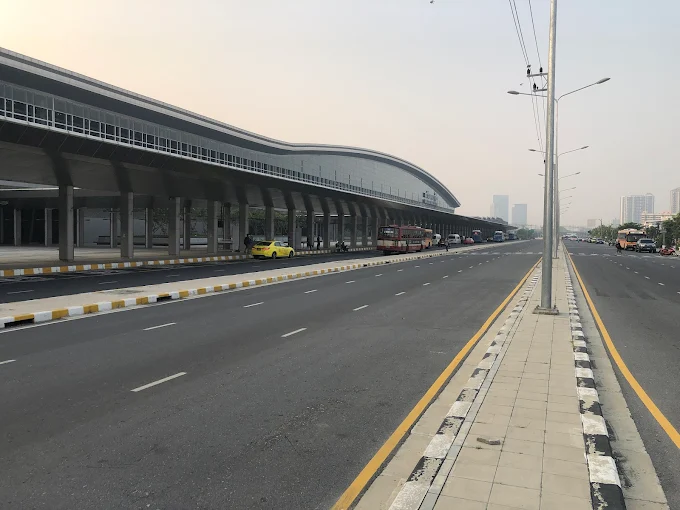
Bangkok Hua Lamphong:
The historic main station from the royal era, still atmospheric but now primarily serving short-haul and commuter trains. It has a dedicated ticket office for foreigners, a food court, and luggage storage.
Features:
• Illuminated architecture with fountain in the foreground.
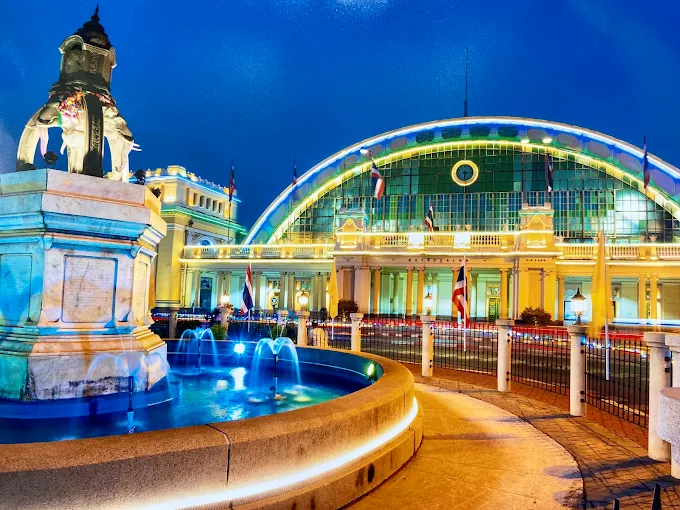
Regional Key Stations
Stations in cities like Chiang Mai, Hat Yai, Surat Thani, Nakhon Ratchasima, Ubon Ratchathani, and Nong Khai feature ticket offices, basic shops, local food vendors, ATMs, waiting areas, restrooms, and onward transport options such as taxis and tuk-tuks.
Local and Small Stations
These range from mid-sized intercity stops to rural halts.
• Mid-sized stations often include platforms, shelters, water, and a ticket booth. Many offer food stalls, bathrooms, and covered seating, but hours may be irregular.
• Rural halts may be very basic, sometimes with nothing more than a raised curb.
Major junctions (e.g., Ban Phachi, Kaeng Khoi) facilitate train connections and generally have more staff. International border stations such as Nong Khai and Padang Besar handle customs and immigration procedures.
Navigating stations:
• Platform numbers are displayed in both Thai and English at major stations.
• Staff are helpful, and security is visible throughout the system, with occasional random checks during peak travel times.
Plan your journey! Book tickets to major or local stations across Thailand.
Planning Your Travel Itinerary by Train
Creating a rewarding Thailand rail itinerary involves balancing scenic routes, practical transfers, and connections to buses or ferries for destinations that are less accessible directly by train.
1. Choose Your Route and Timing
Decide whether to travel during the day or overnight. Consider if you prefer direct routes or multi-stop journeys.
• Major lines typically run several daily departures.
• Overnight trains are a good way to save time and accommodation costs while maximizing sightseeing and experience “sleep and travel” efficiency.
2. Plan Multi-Day Journeys
For classic routes like:
• Bangkok–Chiang Mai–Chiang Rai
• Bangkok–Ayutthaya–Phitsanulok (for Sukhothai)
• Bangkok–Nakhon Ratchasima–Khon Kaen
Schedule stops at towns of interest and link legs with well-timed train connections. While connections are usually reliable, it’s wise to leave a buffer of extra time between trains to account for delays.
3. Transfers and Connecting Modes
Stations like Surat Thani and Chumphon are outside the city center, requiring buses, taxis, or ferries for onward travel to islands like Koh Tao, Koh Samui, Koh Phangan, and Phuket.
• Combination tickets that bundle train, bus, and ferry segments are available on platforms like YesMyTrips, making planning easier and seamless.
4. High-Demand Travel Periods
During peak times such as the Songkran Festival, New Year, Loy Krathong, or events like the Full Moon Party, sleeper berths and express train seats sell out quickly.
• Advance booking is essential to secure your preferred accommodations and seats.
5. Check Published Timetables
Train schedules are updated seasonally and are available on platforms like YesMyTrips.
• Always verify departure times, especially when planning multi-leg trips, to ensure smooth connections.
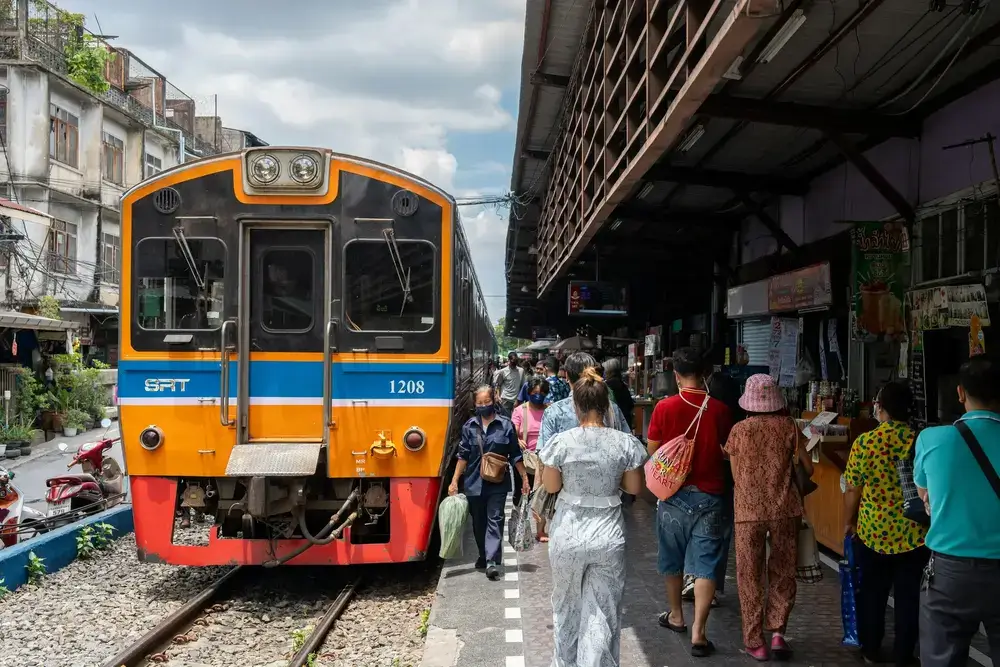
Popular Train Routes in Thailand
Thailand’s rail network offers several unmissable journeys, each with practical and touristic appeal.
| Route | Distance | Duration | Key Highlights | Classes Available | |
|---|---|---|---|---|---|
| Bangkok–Chiang Mai | 751 km | 10–14 hours | Mountains; history; Doi Khun Tan; tribal villages | 1st, 2nd, 3rd, sleepers | |
| Bangkok–Surat Thani | 678 km | 9–15 hours | Beaches, Gulf islands, national parks | 1st, 2nd, 3rd, sleepers | |
| Bangkok–Nong Khai | 624 km | 9–12 hours | Isaan culture, border to Laos, rice fields | 1st, 2nd, 3rd, sleepers | |
| Bangkok–Ubon Ratchathani | 575 km | 9–11 hours | Isaan food, rural temples, border proximity | 1st, 2nd, 3rd, sleepers | |
| Bangkok–Hua Hin | 212 km | 3.5–4 hours | Beach resort town, historic station | 2nd, 3rd | |
| Bangkok–Aranyaprathet | 255 km | 4–5 hours | Rural east, gateway to Cambodia (Siem Reap) | 3rd |
Notes:
• Sleeper services and air-conditioned berths are especially popular on the longer routes like Chiang Mai, Surat Thani, and Nong Khai.
• Trips to Surat Thani are essential for island-hopping adventures, connecting travelers to Gulf islands.
• The Kanchanaburi route offers the iconic Death Railway, a heritage journey through WWII history.
• The Eastern line to Aranyaprathet is the primary overland route heading towards Cambodia.
Discover the most popular train routes in Thailand and book your tickets today!
Scenic Train Routes and Experiential Journeys
Thailand’s railway routes wind through a country blessed with stunning landscapes and rich cultural sights, making some lines among Asia’s most photogenic. Here are two of the most scenic journeys:
Bangkok–Chiang Mai (Northern Line):
Often regarded as Thailand’s most picturesque train route, this journey passes through lush rice paddies, deep mountain valleys, jungle-covered hills, and notable sites like Doi Khun Tan National Park, the long Khun Tan Tunnel, and misty bridges. In the early morning, arriving in northern Thailand reveals mist-shrouded fields and tranquil rural villages, particularly striking during the winter months (November–February) and after the rains. Highlights include the iconic Tha Chomphu Bridge with its striking white arches and the Bavarian-style station at Ban Pin, both perfect stops for photography.
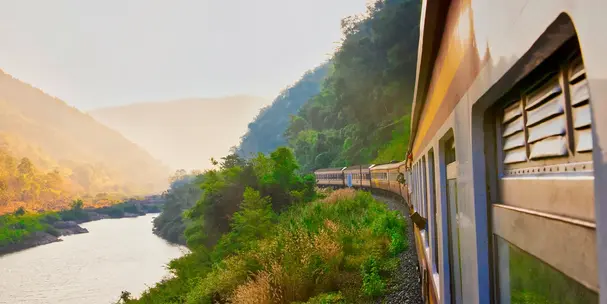
Bangkok–Hua Hin–Surat Thani–Hat Yai( Southern Line):
This coastal route offers panoramic views of salt flats, coconut plantations, and sleepy fishing villages as it crosses the Gulf of Thailand. The ornate and historic Thai-Victorian Hua Hin Station stands out as a destination for architecture enthusiasts. Along the way, travelers are treated to stunning vistas of the ocean, palm-lined cliffs, and vibrant sunsets near Surat Thani.
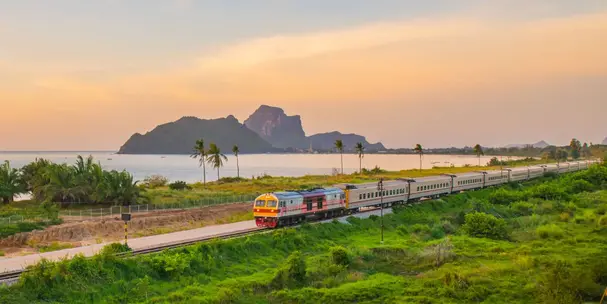
Book a scenic train journey and experience Thailand's beauty!
Types of Trains in Thailand
Special Express: Special Express trains are the fastest long‑distance services operated by the State Railway of Thailand.
• Purpose: Connect major cities with fewer stops and faster journey times.
• Typical onboard options: Air‑conditioned first and second class with sleeping berths on overnight services and reserved reclining seats on daytime runs.
• Where you’ll see them: Bangkok to Chiang Mai, Bangkok to Hat Yai, key trunk routes.
• Ticketing: Reservations are recommended and often required for sleeping berths and first class. Book early for holiday periods.
• Who should use them: Travelers who value speed, comfort, and guaranteed seats or berths.
Express and Rapid Trains: Express and Rapid trains balance speed and coverage for medium‑distance travel.
• Purpose: Serve important intercity routes with more intermediate stops than Special Express.
• Typical onboard options: Reserved and unreserved second class seating, some sleeper coaches on longer overnight services. Air conditioning is common on Express services and less common on Rapid services.
• Where you’ll see them: Major north, northeast, and southern corridors linking regional capitals.
• Ticketing: Reservations recommended for Express; Rapid trains sometimes allow walk‑on travel for unreserved seats.
• Who should use them: Travelers who want decent speed and lower fares than Special Express without sacrificing too much comfort.
Classes of Train Seats and Comfort Levels
Understanding seat and berth classes is essential to a comfortable journey, as Thailand’s trains offer a range of options from luxury to basic local experiences. Discover the various Thai train classes in detail with YesMyTrips and plan your perfect journey.
| Class Type | Description | Features | Best For | |
|---|---|---|---|---|
| First Class Sleeper | Private 2-berth A/C lockable cabins (can book entire compartment for solo travel) | Bedside table, power outlet, sink, shared shower, privacy, dining options; best on Special Express trains | Couples, privacy seekers | |
| Second Class Sleeper A/C | Open-plan berths (curtained, upper/lower), A/C, converted at night | Clean bedding, curtains, reading light, power sockets, under-seat storage | Solo, families, budget conscious | |
| Second Class Sleeper Fan | Identical to above but with fans, windows can open | Cheaper option, warmer in summer, older carriages | Backpackers | |
| Second Class Seats (A/C) | Reclining, reserved seats, A/C | Foldable tables, armrests, ideal for day travel | Day trippers | |
| Second Class Seats (Fan) | Reclining padded seats with fans, open windows | Good for short hauls, classic experience | Locals, short trips | |
| Third Class Seats | Wooden or basic benches, fans, open windows | Cheapest, most local, can be crowded/disorderly | Adventurers, locals |
Amenities and Features:
• First and Second Class (A/C) trains typically offer surprisingly good amenities: fresh linen, blankets, pillows, reading lamps, and safety features such as lockable doors (first class) or privacy curtains (second class).
• In 2025, many main routes feature modern, clean Chinese-built (CNR) carriages, with accessible features and women-only or family compartments on some trains.
The Basic Experience:
• Third class is simple and social: wooden benches, open windows, ceiling fans, and a lively platform environment with local food vendors.
Choose your comfort level! Book tickets in your preferred class.
Ticket Booking and Reservations
Booking Thai train tickets has never been easier, especially through YesMyTrips, which offers a seamless, reliable booking experience tailored for travelers.
Where and how to book
• YesMyTrips (recommended): Book online for convenience and reliability. Select your train, class, berth, and pay by credit card or e-wallet. Your confirmation can be printed or stored on your phone.
• SRT e-ticket (dticket.railway.co.th): Use this platform for the lowest fares and to avoid third-party fees. Be patient if the website or payment process is slow.
• At the station: Major hubs have staffed counters and some foreigner‐specialized service desks for immediate transactions, especially if you prefer cash. For sleeper trains, prefer advance online booking.
• By phone: Call SRT 1690 for reservations or schedule questions. Note that English service may be limited and operation hours are during business times.
Practical Tips & Key Facts
• Book early: Reserve at least 2–4 weeks in advance for popular sleeper trains and holiday periods, these routes tend to sell out fast.
• Secure premium seats: First-class sleepers and upper/lower berths on routes like Bangkok–Chiang Mai and Surat Thani are in high demand and sell out quickly.
• Same-day tickets: Generally limited to local or commuter services, or third-class seats. Availability is not guaranteed for longer routes.
• E-ticket & ID: Carry your e-ticket (on your phone or printed) along with matching photo ID or passport. The name and passport number on the ticket must match your ID.
• Cancellations & changes: Allowed with fees, full refunds typically require cancellations prior to departure. Check the specific policy when booking.
• Waiting list: Some trains offer a waiting list. On YesMyTrips, click on the bell icon to receive a notification when the train becomes available for booking.
Short checklist before Booking
• Decide your route and class (sleeper vs. seat).
• Book early for overnight or holiday travel.
• Confirm names and passport numbers match your travel documents exactly.
• Save or print e-tickets and payment confirmation screenshots.
• Review cancellation and refund policies before finalizing your payment.
Book your train tickets now! Don't miss out on your preferred travel dates.
Understanding Train Schedules and Timetables
Thailand’s train numbering system and punctuality patterns may seem complex at first, but are straightforward once familiarized.
Train Numbers and Codes:
• Special Express: 1–48 Limited stops, the fastest service.
• Express: 51–98 Intercity routes with fewer stops.
• Rapid: 101–198 Slower trains with more stops.
• Ordinary: 298–300 All stops, the slowest.
• Commuter: 301–398 Short-haul, serving Bangkok suburbs and nearby areas.
• Local: 401–498 Provincial and rural routes.
Schedules and Reliability:
• Timetables: Departure and arrival times, journey durations, and stopping patterns are available through YesMyTrips.
• Seasonal factors: Schedules may be adjusted during peak seasons, festivals, or for special scenic trains, with some trains (e.g., the floating train) operating only during cooler months or holidays.
• Punctuality: Generally reliable, especially for Special Express and Express trains. However, delays of 30 minutes to several hours can occur due to single-tracking, weather, or mechanical issues.
• Rural and scenic trains: Frequencies and schedules may vary, so check online or ask station staff for the latest info.
Additional Tips:
• Printed schedules: Available at main stations, often in English, especially for popular routes.
• Rural stations: Check online or with staff at smaller stations for train frequency and timetable updates.
Night Trains and Sleeper Services
Thailand’s night trains are a travel highlight, blending efficiency, adventure, and a glimpse into Thai social life on the move.
Popular Night Train Routes
• Bangkok–Chiang Mai: Four nightly sleeper trains, from modern Chinese-built CNR carriages to older but comfortable Daewoo stock.
• Bangkok–Surat Thani: Popular with backpackers heading south for island hopping; six overnight trains featuring 1st and 2nd class sleepers.
• Bangkok–Nong Khai and Ubon Ratchathani: Border routes heading toward Laos and the east.
• Bangkok–Hat Yai, Trang, Nakhon Si Thammarat, Kantang, Su-ngai Kolok: Cover southern Thailand and Malaysia border crossings, favored by adventurous travelers.
Cabin Types and Booking Tips
• First Class: Two-berth lockable cabins with A/C, private but sharing showers (hot water available on CNR trains).
• Second Class: Open-plan curtained berths, with options of A/C or fan; upper and lower berths are priced differently.
• Third Class: Not typically recommended for overnight travel due to limited comfort, but available for resilient travelers willing to rough it.
How to Sleep Comfortably
• Book early, especially for lower berths, which are wider, have windows, and are easier to access.
• Staff usually convert seats into beds between 8–9 pm, providing fresh linen, blankets, and pillows.
• Bring: Eye masks and earplugs (carriage lights stay on all night), a light sweater or blanket (A/C can be cold).
• Security: Trains are patrolled by staff and police. Keep valuables secure, use small padlocks, and keep luggage within sight while sleeping.
• Onboard Dining: Most sleeper trains have dining cars offering basic Thai meals and breakfast. Food carts circulate throughout the night.
• Wake-up Calls: Staff will gently wake you before arrival. Plan your onward transport in advance at larger stations.
Baggage Policy and Practical Onboard Rules
Luggage allowances are officially generous, but enforcement is flexible. Practical advice emphasizes manageability, security, and comfort.
| Class | Official Allowance per Passenger (kg/lbs) | Real-world Experience | |
|---|---|---|---|
| First | 60kg / 110lbs | One medium suitcase or bag per berth, plus a daypack, fits easily in cabins. | |
| Second | 40kg / 88lbs | Bags can be stored under lower berths, in overhead racks, or at the end of the carriage. | |
| Third | 30kg / 66lbs | Space under benches or on racks; keep bags within sight for security. |
Practical Tips:
• Bulky Items: Bicycles are permitted on some express and rapid trains if space allows; check ahead. Expect to purchase a freight ticket. Large suitcases can be cumbersome in narrow corridors.
• Luggage Storage: Use locks or cable ties to secure luggage on racks. Keep valuables with you or sleep next to your bag.
• Food and Drinks: Allowed and encouraged. Vendors board at stations, or bring your own supplies. Alcohol sales are banned on trains but may be available (in limited hours) at stations.
• Smoking: Strictly prohibited aboard all trains.
• Mobile Connectivity: Signal quality can be patchy, especially in remote or mountainous areas. Power outlets are available in newer carriages.
• Pets: Allowed in third class and cargo, provided they are caged and registered in advance.
• Behavior & Quiet Zones: Respect quiet zones during night hours; maintain a respectful silence for fellow travelers. Daytime is generally more social.
Train Safety Tips and Local Culture Experience
Personal and Property Safety
• Valuables: Always keep valuables locked or within your sight. Use cable locks on bags, and carry essentials like wallet, passport, and phone on your person, especially during night travel or when sleeping.
• Onboard: SRT staff and patrol police are present, especially on busy routes and at night. Serious crime is rare, but petty theft, such as unattended bags, can happen.
• Health & Hygiene: Carry snacks and bottled water to stay hydrated. Train toilets are generally clean, but bringing your own toilet paper and sanitizer is advisable.
Embracing the Cultural Experience
• Onboard Life: Thai trains are social environments, especially in 2nd and 3rd class. Sharing snacks, chatting with fellow travelers, and observing customs, such as removing shoes and greeting politely, enhance your journey.
• Dining: Sample local dishes from vendors at stops. Each region features its own specialties, turning train journeys into food adventures.
• Interaction: Station and train staff are often helpful; in major stations, basic English is usually spoken.
• Local Sights: Many stations feature markets, riverside scenery, Buddhist temples, and impromptu performances, adding to the cultural charm. Special excursion trains (e.g., to Pasak Dam or Kanchanaburi) offer deeper cultural immersion.
Tips for Enjoying the Railway Experience
• Be Polite & Flexible: Delays are common, but they offer more time to observe and mingle with locals.
• Learn Basic Thai: Simple greetings and smiles go a long way in making connections.
• Enjoy the Unexpected: Appreciate spontaneous moments—like a vendor’s story, scenic sunrises, or local performances—as part of the adventure.
Final Takeaways
Train travel in Thailand offers a practical, affordable, and culturally rich way to explore the country. Whether riding a plush overnight sleeper, hopping a daytime local train to a bustling market town, or crossing historic bridges and tunnels, the journey truly becomes part of the destination. With thoughtful planning, flexibility, and these actionable tips, travelers of all backgrounds will find the railway an unforgettable way to experience the heart of the kingdom.
| Feature | Details | |
|---|---|---|
| Operator | State Railway of Thailand (SRT) under Ministry of Transport | |
| Network | Approximately 4,400 km, spanning 5 main lines | |
| Key Hubs | Krung Thep Aphiwat (Bangkok), Chiang Mai, Hat Yai, Surat Thani | |
| Main Seat Classes | First (private cabins), Second (sleepers/wide seats), Third (benches) | |
| Booking | Online via YesMyTrips and SRT website, at major stations | |
| Timetables/Delays | Generally reliable; delays can occur on single-track sections; schedules may vary seasonally | |
| Night Trains | Available on all major lines, especially popular to north and south routes | |
| Luggage Policy | Official allowances: 60kg/40kg/30kg; enforcement is relaxed; mobility is key | |
| Onboard Food | Dining cars and carts on long routes; vendors at smaller stops | |
| Safety | Generally excellent; staff present, rare crime incidents | |
| Cultural Experience | Local vendors, markets, spontaneous conversations, and warm Thai hospitality |
Frequently Asked Questions
Yes! The easiest way is through YesMyTrips.com, which offers a secure, user-friendly platform to browse routes, select classes, and book tickets in advance. You can also purchase tickets at train stations or by phone, but online booking provides confirmation by email and seat selection.
Most major credit and debit cards are accepted on YesMyTrips.com, making it convenient for travelers worldwide. You can also use some e-wallets like Apple or Google.
You can book tickets up to 6 months ahead on YesMyTrips.com, especially for popular sleeper train routes, making it ideal for planning peak-season travel. Options include reclining seats, sleepers with private cabins, and luxury first-class sleepers.
Thailand trains offer First Class sleepers (private cabins), Second Class (air-conditioned or fan sleeper berths, reserved seats), and Third Class benches. Check YesMyTrips.com for availability.
Ordinary trains stop at all stations and are slower, while Rapid and Express make fewer stops for quicker travel. Special Express trains are the fastest, with limited stops and more amenities, early booking on YesMyTrips.com is recommended.
Popular routes include Bangkok–Chiang Mai (scenic Northern Line), Bangkok–Surat Thani (for islands), and routes to Kanchanaburi and Ubon Ratchathani. You can check schedules and scenic options through YesMyTrips.com.
Prices vary by route and class, with the cheapest option being Third Class benches. On YesMyTrips.com, you can often find discounts and promotions to save money. Follow us on Facebook to stay informed about the latest deals and offers.
Sleepers are designed for comfort, with bedding, linen, privacy curtains, and sometimes air conditioning. Some trains also have toilets or dining cars.
Dining cars and carts serve meals and snacks on long routes. You can also bring your own food and drinks, but alcohol sales are limited to stations.

